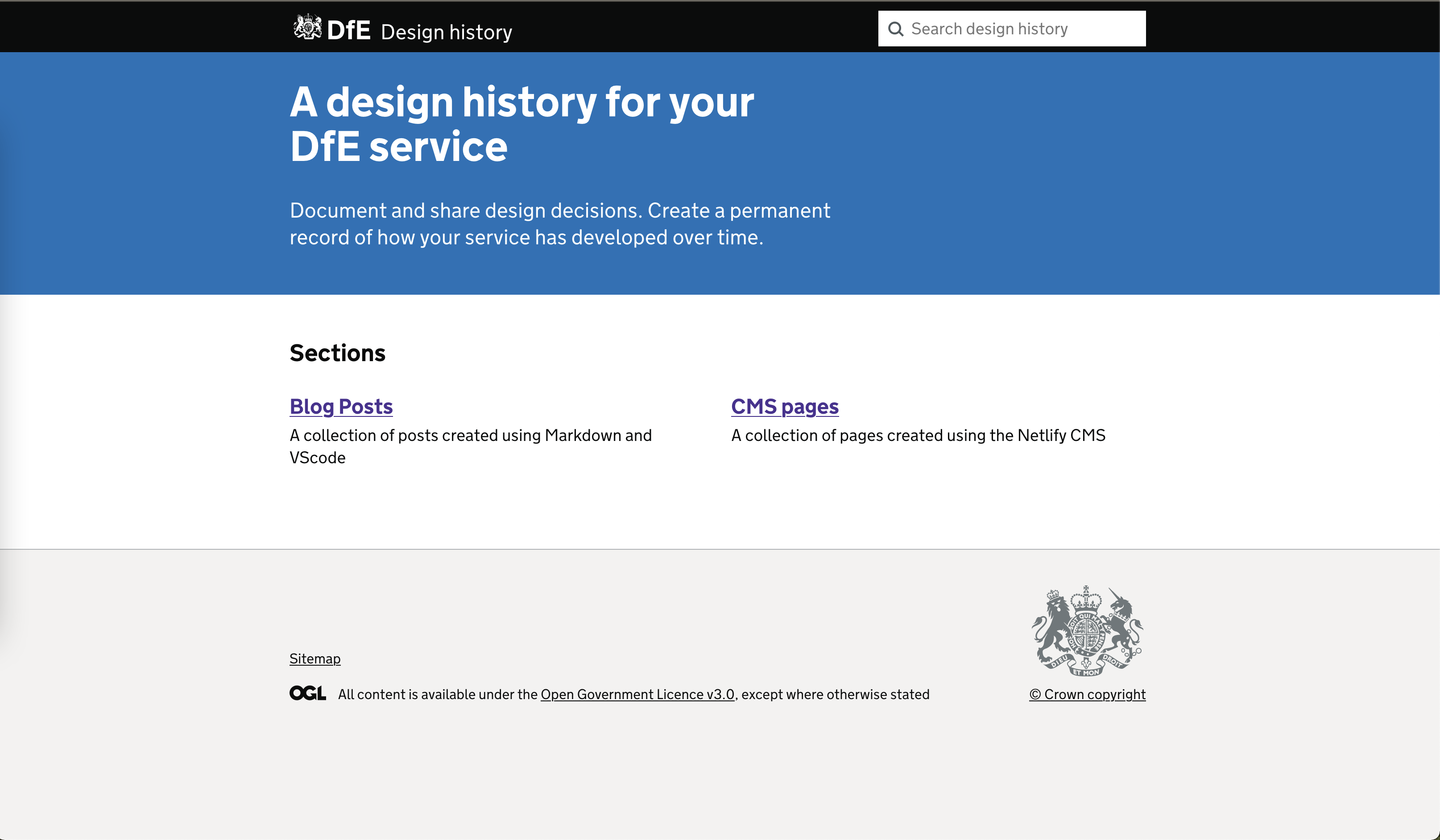What are they?
The ‘design histories’ have been around for more than a couple of years. Originally created by the interaction designers of the BAT (Becoming a Teacher), their design history BAT design history.
Well over two and a half years ago I created the same for the SDD (Solutions Delivery and Design), SDD design history. Since then it became apparent that not all Service and Interaction designers can use it efficiently, and write design histories in a consistent manner. Therefore I decided to add a CMS on the ‘design histories’. To allow more adoption and a consistent design going forward.

Netlify CMS Design
I have chosen to create the CMS using the Netlify CMS. Netlify CMS is based on client-side JavaScript, reusable APIs and prebuilt Markup. In a nutshell it is single page React application served via a CDN, this means better performance, higher security, lower cost of scaling, and a better developer experience. It is also Open Source, even though with a higher learning curve if you decide to host somewhere else rather than Netlify
What is a design history?
When designing and building a service, it can be easy to forget why previous decisions were made, even more so as new people join the team and others leave. A design history can help by creating a permanent record.
A design history site is like a blog, with posts describing the development of new features, iterations of existing ones or findings from user research – anything that may be useful to return to later.
This project was developed by the Becoming a teacher team at the Department for Education who found that by keeping a design history, they could:
- re-evaluate decisions
- see how a feature changed over time
- see how things tested in research
- give context to new team members
- demonstrate reasons why certain features did not work
- create snapshots of how things looked at significant milestones
- share design decisions across government
- share everything with service assessors
As of February 2020, the Becoming a teacher design history includes more than 200 posts documenting 5 different services. You can learn more about how and why the team created their design history on the DfE Digital blog.
I believe that in the process of teaching design leaders and their team how to create and use Design Histories you set design direction and good practice
Design Histories are a practice used to document and share the context, decisions, and evolution of design work within an organization. They serve as a valuable resource for designers, teams, and stakeholders to understand the rationale behind design choices and the journey of a particular project or product. Design Histories can be created and utilized in various ways, but they generally include information such as project goals, research insights, design iterations, user feedback, and key decisions made along the way.
The Government Digital Service (GDS) blog and the Department for Education (DfE) in the UK have recognized the importance of Design Histories in creating the right conditions and environment for designers to thrive. Here’s how they contribute to this goal:
-
Knowledge sharing and transparency: Design Histories promote transparency by documenting the design process and making it accessible to others. They enable designers to share their work, insights, and lessons learned with colleagues and stakeholders. This open sharing of information helps create a culture of learning, collaboration, and continuous improvement within an organization. Designers can build upon each other’s work, avoid duplicating efforts, and make informed design decisions based on previous experiences.
-
Institutional memory: Design Histories serve as a repository of institutional memory within an organization. They capture the context and reasoning behind design choices, ensuring that valuable knowledge and insights are not lost when team members move on to new projects or leave the organization. This continuity of information helps maintain consistency and enables new designers to understand the evolution of a project, learn from past decisions, and avoid repeating past mistakes. It also fosters a sense of collective ownership and shared responsibility for design outcomes.
-
Design process improvement: By analyzing past Design Histories, teams can identify patterns, successes, and failures in their design processes. They can gain insights into what worked well, what didn’t, and areas that need improvement. This iterative approach allows designers to refine their methods, tools, and workflows over time, leading to more effective and efficient design practices. Design Histories enable teams to measure progress, assess the impact of design decisions, and continuously iterate towards better outcomes.
-
Stakeholder alignment: Design Histories provide a documented record of design decisions and the rationale behind them. This documentation helps align stakeholders, including product managers, developers, and executives, with the design direction. It facilitates better communication and understanding among team members, ensures that everyone is on the same page regarding design goals and constraints, and helps manage expectations. When designers have a clear and well-documented history of their work, they are more likely to receive the support, resources, and trust they need to succeed.
Overall, Design Histories play a vital role in supporting designers by fostering a culture of transparency, learning, and improvement. They provide a shared understanding of design decisions, promote collaboration and knowledge sharing, preserve institutional memory, and facilitate stakeholder alignment. By leveraging Design Histories, organizations can create an environment where designers can thrive and make informed design choices that positively impact products, services, and user experiences.